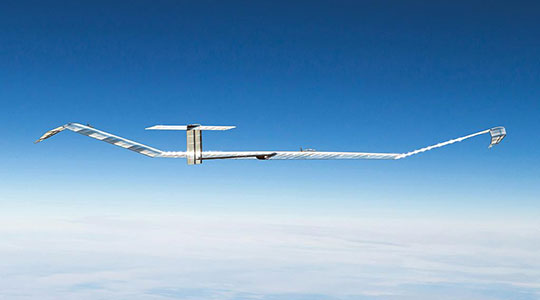 AALTO HAPS high-altitude Zephyr aircraft. (Source: AALTO HAPS)
AALTO HAPS high-altitude Zephyr aircraft. (Source: AALTO HAPS)
Constellations sat down with Samer Halawi, CEO of AALTO HAPS (High Altitude Platform Stations), a nascent technology that, if successful, could provide communications connectivity to some of the world’s 1.7 billion unconnected people. Halawi explained why he believes HAPS could be a viable competitor, especially in areas that are communications deprived.
“The HAPS technology … we’re trying to build is new. No one has successfully, or no one has yet built a market with HAPS yet,” said Halawi. Earlier versions of HAPS relied on balloons as platforms. However, it was difficult to control their direction and they were soon replaced with aircraft, like AALTO HAPS that are capable of loitering in any particular position and also following a defined path.
Halawi said that “[HAPS] can fly in the sky, in the stratosphere in particular, over 60,000 feet and keep them there not for a day or two or for hours, but for months at a time.” Halawi explained that at 60,000-80,000 feet, HAPS fly much lower than satellites enabling them to connect directly to end users.
A Terrestrial Tower in the Sky?
The need to increase connectivity to the less connected or unconnected areas of the world has led to the development of different approaches, from satellite phones to the emerging satellite direct-to-device service. HAPS aim to provide a similar service.
As Halawi explains, “Your iPhone or Android phone can communicate directly with the HAPS, and it can turn the HAPS into a cell tower in the sky. This is a breakthrough. This allows a capability, a technological capability that is fully aligned with the economics of the markets that it’s trying to serve.”
Battery Technology Is Key to Growth
According to Halawi, AALTO’s growth will be accelerated by the addition of strategic partners and the continued advances in battery technology. As for partners, he explained, “Airbus is not very experienced in building telecom services. So, what we have decided to do is to give the opportunity to strategic type partners that come with us and who can bring value into the project.”
According to Halawi, continued advances in battery technology will be important to the growth of HAPS. He acknowledged that HAPS technology has been around since 1945, but improved battery technology, due in part to the auto industry’s push into EVs, has evolved to better support market needs.
“I think the most important element is the battery,” Halawi said. “Solar panels, as well, are important, but the battery technology is the key and that will keep driving the development of HAPS. And as batteries improve, what happens is you can pack more capacity into the small mass of batteries. With that, you can carry heavier payloads and be able to serve more people to do different things.”
Click here to learn more about Earth imaging, cell tower economics and HAPS’ value proposition.
